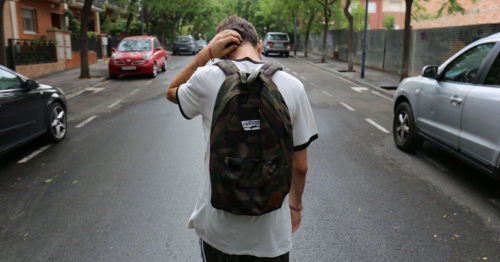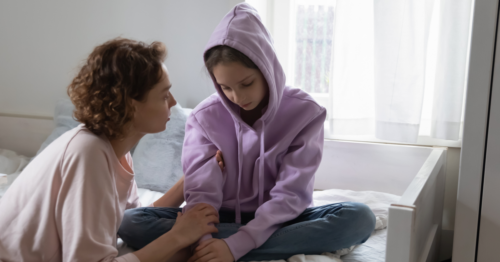
Table of Contents
From Their Perspective: Understanding the Youth Mental Health Crisis
Written By: Charlie Health Editorial Team

Clinically Reviewed By: Dr. Jaime Ballard
September 27, 2022
7 min.
A desperate need for mental health support among youth calls for a closer look at their lived experiences.
Learn more about our Clinical Review Process
Table of Contents
Whether you’re a young person, a parent, a mental health professional, or simply someone who’s familiar with mental health trends, you’ve likely heard about the youth mental health crisis in the U.S.
While mental healthcare needs to be improved for children and youth—including long-term changes at the institutional level—there are actions individuals can take to improve environments and relationships, offer more support, and develop a richer understanding of issues that affect adolescents and teens.
One of the first and most important steps involves checking in with young people. Studies offer helpful insights, but they only go so far—and so deep. The more opportunities adolescents and teens have to share their experiences without judgment, the more the adults in their lives will be able to understand their views, challenges, and needs. And, ultimately, they will be more prepared to take the steps to implement change where it’s needed most.
The youth mental health crisis
Mental health conditions are affecting young people’s lives on a profound level. A report from the COVID States Project shows that 50% of young people age 18-24 are experiencing moderate or severe depression, while another 23% have mild symptoms. Depression is one of many conditions on the rise.
Though COVID-19 added its own unique complications to this issue, mental health challenges were already prevalent, even before the pandemic. According to the U.S. Surgeon General’s 2021 Advisory, “Protecting Youth Mental Health,” these challenges continue to be the leading cause of poor life outcomes and disabilities in America’s youth.
In December 2021, the Office of the Surgeon General released an advisory regarding youth mental health. These advisories are reserved for significant public health issues that require immediate awareness and action. Contributing factors, the advisory notes, are varied. Environmental factors and relationships impact young people’s mental wellbeing, from their homes and schools to families, social networks, communities, and cultures.
We need to improve mental health care for adolescents and teens. Despite limitations in how individuals can impact institutions at large, we have the ability to make a difference by listening to—and learning from—young people’s voices and experiences.
A closer look at mental health
How would you define mental health? The CDC describes it as our emotional, psychological, and social well-being. Our mental health affects how we think, feel, and act, along with our ability to navigate life, adapt, cope, and form fulfilling relationships.
If you ask young people, their answers might be a bit more nuanced. One 2021 study includes findings from interviews with adolescents and young adults ages 17 to 25. This kind of research—in which young people’s perspectives on their own lived experiences are taken into account—is scarce, but illuminating.
Researchers found that when young people talk about mental health, they focus less on their individual thoughts and feelings and more on relationships, as well as the overall complexity of mental health.
Social media expectations take a toll, according to some interviewees. Constant comparison is exhausting and disheartening, especially when peers, at a glance, seem to have it “all together.” In their interviews, youth described many sources of mental health problems, including:
- Growing academic stress and pressure
- Managing relationships with peers, parents, and others
- Lack of a clear, “accepted” way to express mental health struggles
- Limited or no access to adults who can be present, listen, and offer support
The prevalence of mental health challenges also varies among subpopulations. For example, socioeconomically disadvantaged youth are two to three times more likely to develop mental health conditions than those with higher socioeconomic status.
BIPOC and LGBTQIA+ youth also report unique struggles tied to minority stressors such as discrimination and a lack of support and acceptance in their communities and environments. While some contributing factors overlap, lived experiences vary widely, making it even more critical for adults to hear diverse perspectives, and to listen for the personal experiences of the youth in their lives.
Barriers to seeking help
It’s also important to understand why young people might have a hard time finding support, or even asking for help in the first place. Even though young adults are struggling with mental health more than any other age group, many of them don’t receive treatment.
Researchers found that 48% of young adults experienced mental health symptoms in 2021, compared to 20% in 2019. However, only one third received treatment, while another third reported they wanted support but did not receive it.
Why is it so hard to receive mental healthcare as a young person? Reasons vary, but research—including interviews with teens—points to some of the more common roadblocks.
- Self-reliance & resistance
Young people may want to “handle it themselves.” There’s a desire for independence and, at times, a fear of relying on another person, committing to recovery, or depending on medication—despite the fact that the right resources can be incredibly helpful. - Lack of knowledge
Teens struggling with mental health issues may experience low mental health literacy, meaning they’re uninformed about symptoms, available resources and coping skills. Demographic disparities contribute to this as well. - Fear of judgment
Many young people don’t want to be seen as “lazy” or a “burden” when asking for mental health support from peers or adults. They may also worry about not being taken seriously. - Instability
Youth without supportive adult relationships, people they can picture being empathetic if they share a concern, are less likely to seek support when they need it. - Need for confidentiality
Those struggling with mental health need to know that their thoughts and experiences will be kept secret, unless otherwise specified. Confidentiality creates a safe environment where open sharing is possible. - Possible repercussions
If young people think there’s a chance they might face repercussions at home, school or work for requiring mental health support, they may opt to stay silent instead.
Adults who interact with adolescents and teens—parents, teachers and the like—can help eliminate some of these barriers. It’s critical for adults to inform young people about their options, check in with them on a regular basis and create safe and open environments for honest communication.

The power of perspective
We know young people struggle with mental health, but do we know enough about their daily lived experiences? Some research includes insights from interviews, which helps enrich our understanding. There are also efforts to involve young people in research and share their specific stories.
One example is a review from Karolin Krause at the Center for Addiction and Mental Health in Toronto, Canada. This review explored whether problem-solving training might help alleviate symptoms of depression in young people. Contributors included a panel of 12 youth advisors. Together, they were able to help review evidence and contextualize findings. They learned that, while problem-solving training might help some young people work through personal challenges, it may not be enough to combat depressive symptoms requiring more comprehensive support.
Reviews like Krause’s highlight the value of collaboration. The more clinicians, researchers, and communities are open to working with young people, the better equipped they can become to gain deeper insights and offer support.
Another example of work that not only involves young people directly, but also highlights their first-person accounts, is the PBS documentary, “Hiding in Plain Sight: Youth Mental Illness.” The film features interviewees from ages 11 to 27 who open up about their struggles and share how they’ve found help. Topics like discrimination, bullying, and stigma are also addressed.
Whether it’s a research article, film, or treatment approach, young people’s perspectives are essential. The more we can involve them in conversations about mental health, the more we can learn—not just from statistics, but from stories, too. Sharing their experiences can also help normalize the need for mental health care among teens and adults alike.
More ways to offer support
Mental health issues are something most of us encounter, wherever we are in life. This commonality opens up room for dialogue—the more we talk about these issues, specifically with young people, the more we can break down stigma and reduce fear. Here are a few more ways adults can promote better mental healthcare for adolescents and teens:
- Listen
This is something that’s been stated already, but can’t be emphasized enough. Teachers, mental health professionals, and parents: actively listen to the young people in your life when they talk about mental health. - Validate
Make sure their feelings and experiences are validated. Remember, young people may fear not being taken seriously.
- Ask
Without pushing, asking more questions (like “How are you, really?”) shows you’re genuinely interested and care. It also creates more space for them to share. - Be proactive
You don’t have to wait until someone “looks” like they’re struggling. Instead, check in and let them know you’re available to listen and support. - Inform
At school, teachers and staff members should consider the best ways to inform students and parents about counseling and any other resources. - Lead by example
When appropriate, share your own experiences. Let them know that “failure” is okay and “perfection” doesn’t exist. - Empathize
Put yourself in their shoes. This will help them feel understood and develop their own capacity for empathy, too.
Once we put these behaviors into practice, we can work together to create a brighter future for adolescents and teens struggling with mental health.
If you or someone you know might benefit from extra support, Charlie Health offers virtual intensive outpatient treatment for adolescents, young adults, and their families. Our intensive outpatient program helps teens and young adults understand and overcome their mental health challenges. Contact us with any questions and connect with a member of our Care Team.





